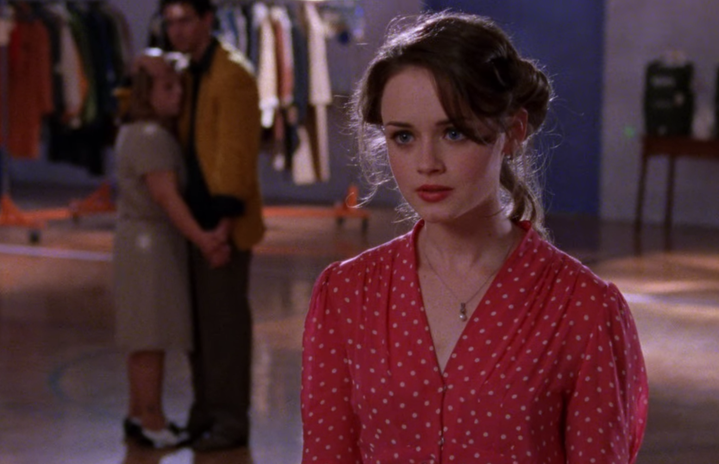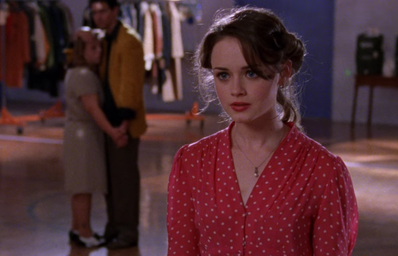As a Gen Z Gilmore Girls fan, I can honestly say that I love the show and the quick-talking fun characters that come along with it. That said, as I’ve started my fifth rewatch (and yes, I mean my fifth), joining countless other fans for a fall binge of the show, the flaws that come along with these characters have also become pretty evident, and apparently, other Gen Z’ers agree. That’s right — the internet has labeled Rory Gilmore the villain of the show, despite her former reputation as a Millennial icon. Many fans have been speaking out about Rory’s problematic behavior and lack of personal responsibility, but how exactly did this downfall come to be?
RORY, check your privilege
Rory Gilmore is an interesting character in terms of her representation as a female figure. Her character created an on-screen counterpart for all of the shy teen girls who felt slightly out of sync with their peers and experienced their fair share of social awkwardness (remember when she accidentally shoplifted cornstarch and ran away after her first kiss?). There was finally a high school protagonist who would rather read or watch movies with her mom instead of going to parties. Rory didn’t constantly worry about diets and popularity, yet she was still able to have solid friendships and romances. She did all of this keeping her ambitions intact and dreaming of a successful career.
As many Millennials watched Gilmore Girls in their teen years, they saw Rory as a lovable, relatable idol, but these views have quickly been replaced by Gen Z’s recognition of her privilege. “Rory’s whole life, she’s had everything handed to her and has been praised for so much. I think it got to her head and made her think she could do whatever she wanted with no consequences,” says Logan, 20, a junior at the University of Maine.
Given that student loan debt has more than doubled between 2008, a year after the show ended with Rory’s graduation, and 2020, a graduation year for Gen Z college students, Rory’s financial privilege exacerbates Gen Z’s perception of her entitlement. Throughout the original seven seasons of the show, Rory goes through private school and an Ivy League college all without the need for any loans from sources outside of her family. After college and throughout the revival, when Rory turns down multiple job offers even when she has no source of income, the financial cushion provided by her family and friends became jarring to the Gen Z audience. In a 2019 survey of over 1,000 college students, 61% stated they would accept a job offer they’re not passionate about because of pressure to pay off student loans, so Rory’s plight isn’t exactly relatable.
On top of that, Rory is consistently successful in the majority of her endeavors, with minimal criticism. Maeve, 21, a senior at Pace University, says, “She was entitled and unable to take criticism and it became her downfall over time. Everything I initially fell in love with the character for at first went away.”
We can see examples of this when Rory decides to “take a break” from Yale because of Mitchum Huntzberger’s criticism (even if it was pretty harsh), and in the revival when she shows up completely unprepared to a job interview with SandeeSays, thinking the job’s a given because she sees it as beneath her. Instead of Rory’s innocence manifesting as charming naivety, Rory’s lack of real-world knowledge acts as a sign of the privilege she has, and a result of the cushion her family provides for her.
The letdown of the college years
In Season 4, Rory begins her time at Yale. At this point in the show, Gen Z watchers tend to pick up on Rory’s impulsiveness and focus on self-gratification, which seems to become increasingly obvious. Rory’s college experience is widely marked as the moment her character really starts to decline. “I definitely saw a change in her behavior as she transitioned from Stars Hollow to Yale,” Allie, 24, a recent graduate of the College of Charleston, tells Her Campus. “Even when she was at private school, she was still the down-to-earth kind girl and I think a lot of that has to do with how Lorelai raised her. When she began dating Logan and hanging out with other rich people, I noticed she was snooty and out of touch with herself.”
While Rory’s motivation and obsession with pop culture in early season often feels relatable to Gen Z viewers and their ever-growing connection to media, the choices she makes as a college student (this includes hooking up with Dean, going on a stolen yacht joy ride, dropping out, and freezing Lorelai out) created a gap between herself and countless viewers. “I am Gen Z and grew up watching Gilmore Girls and LOVED early seasons Rory. I saw so much of myself in her; however, she took a turn for the worse during college (dropping out, hooking up with a married Dean) and it really made me lose interest in her character,” Maeve says. In these instances, many Millennial fans of the show and Rory’s character associate Rory’s mistakes with growing up; however, many Gen Z’ers are still in the process of growing up and experiencing the college years, so Rory’s rash decisions act more as a blueprint for what not to do, adding to their distrust of Rory’s character.
By Season 7, viewers have suffered through four seasons of the inflated self-worth she develops as a result of the Life and Death Brigade’s (aka Logan and his very entitled friends) urging that she embrace her inner rich kid. And without Lorelai acting as a grounding source, Gen Zers all but declare her character arc unsalvageable. Not even the brief character turnaround in the final episodes, which creates a small spark of hope that a spunky and independent Rory will return when she turns down Logan’s proposal and strikes out on her own in the final two episodes, is enough to save her in the eyes of Gen Z, as it offers no acknowledgment of her problematic behavior.
getting older, getting worse
Without that acknowledgment, that spark of hope for an improved Rory is all but obliterated thanks to the 2016 revival, Gilmore Girls: A Year in the Life.
While seeing Rory struggle with the job market and with being an adult in general made many Millennials feel like they could finally relate to their teenage idol again, Gen Z’ers saw a totally different side to the story. Rory’s amorality in the revival — because honestly, who can relate to forgetting about having a boyfriend or having a cross-continent affair with a college ex? — destroys any chance of relatability, and Gen Z can’t get behind the “grown-up” version of her character.
Logan tells Her Campus, “I honestly really enjoyed the original ending [Rory accepting a job reporting on Obama’s campaign trail] way better than Palladino’s ending for the spin-off [Rory surprising the audience and Lorelai with news of a pregnancy]. The spin-off made me upset because I wanted to see Rory doing a lot better than she was!” Of course, all of this can tie back into the privileged life Rory experiences in the original series. As she is one of the only characters who never has a deeply humbling experience (like Lorelai’s teenage pregnancy, Paris’s rejection from Harvard, Lane’s strict upbringing, or Emily’s rift with Lorelai), Rory is never able to see humility as a strength in character.
rory & gen z’s feminist evolution
So why are Millennials able to see Rory as a feminist icon, when Gen Z’ers pick up on so many flaws in her character? The answer is simple: feminist perspectives change over time. For the Millennials who began watching Rory’s journey as Gilmore Girls was airing, Rory really did represent feminism. However, early 2000s feminism, or white feminism, is very different from the version of feminism practiced by members of Gen Z today.
White feminism focuses on individual success and making it within the systems that box women in. This is exactly what Rory focuses on throughout the original series and the revival, so it’s no wonder that she was and still is viewed as a feminist figure by those who were developing their own ideas of feminism in the era of girl bosses. This concept of white feminism makes a case for why it’s harder for Millennial viewers of Gilmore Girls to focus on Rory’s flaws — she represents the role model many of them based their own feminist identities on. Rory’s idols, such as Hilary Clinton, also represent white feminism instead of intersectional practices, something that became clear to Gen Z during Clinton’s run for president in 2016.
On the other hand, Gen Z practices a form of feminism that leans a little more heavily on calling out the marginalization, oppression, and privilege that white feminism works within. This is the privilege that the show not only exemplifies, but also attempts to disguise by making Rory seem like a working-class girl. During her college years and the revival, she describes herself as broke on multiple occasions, and her access to the upper-class world and all its perks are swept under the rug in order to provide the image that she is working her way up the ladder of the career world all on her own. Because Rory’s character represents a lot of the traits of a white feminist girl boss, Gen Z feminists may be out for her in the same way they’re out for white feminism.
The villainization of Rory marks the evolution of feminism. While this evolution is imperative to continuing the upward trajectory of inclusion and intersectionality, it can be difficult for longtime fans to accept that their once-favorite character has a problematic attitude. The trick is to realize that both Millennials and Gen Z can still enjoy Gilmore Girls and what Rory brings to the plot without striving to be her, and while recognizing her bad behavior.
Study Referenced:
Handshake. (2020). Survey: Student Loan Debt Is a Key Factor for Gen Z When Making Career Decisions. Handshake.


